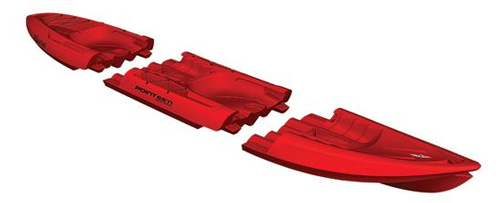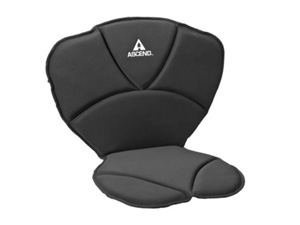
When shopping for a kayak, begin your search using the answers to these two very important questions: How do you intend to use your kayak, and how much money are you willing to spend? With this information sorted out, you're ready to start weighing other options such as kayak design and type, stability, length, weight and materials. No one kayak does it all, but there are plenty of models designed for a variety of applications and a range of paddling experience levels.
Sit-On-Top & Sit-Inside Kayaks
Two common acronyms you'll encounter when shopping for a kayak are SOTs and SINKs. SOT stands for "sit-on-top" kayak. Many recreation models fall into this category. Sit-inside (SINK) kayaks are the other style, and they represent the majority of kayaks. Both styles have pros and cons.
SOTs offer more freedom of movement for your lower body. Many kayak anglers prefer SOTs because you can dangle your feet in the water, shift sideways, and sit cross legged. Some are even stable enough you can stand up in them. With a SOT you don't need to worry about getting trapped inside should you tip because you're on top of the boat. You'll simply fall off the kayak, which is a welcome trait to some who find SINKs uncomfortable. Some beginners also find it easier to get on and off of a SOT model.
SOTs have some disadvantages, though, too. One is that you tend to get wet more often than you do in a SINK. In this respect, SOTs are great for warm weather, but they're not as practical for cool climates. The majority of SOTs self-bail, meaning water drains from the seat and deck through scupper holes; this means there's always a bit of water in the bottom of the boat unless you buy scupper stoppers to fill the holes. If you take on too much water, simply remove the plugs to drain the excess.
 |
Sit-on-Top
|
SINKs provide more protection from the elements than SOTs as your lower body is inside the kayak's cockpit. Because you sit in these models, the lower half of your body is protected from the sun and the rain, unlike in a SOT. You can purchase spray skirts to prevent water from entering the inside of the kayak. The major advantage to SINKs is you stay drier when kayaking, which is critical in cool climates and foul weather.
The downside to SINKs is you don't have as much freedom to move your legs around. SINKs tend to require a bit more finesse to get in and out of than SOTs. These models don't self drain, making them drier than SOTs, but you'll need to carry a bilge pump to remove excess water.
 |
Sit-Inside
|
Whether you choose a SOT or SINK kayak comes back to your intended use and personal preferences. If you're only looking to paddle short distances in sunny, warm weather a SOT may suit your needs best. If you plan to tour or kayak camp on multi-day outings, a SINK is probably the better option to ensure you're protected from a range of weather conditions.
Other Consideration When Making a Kayak Purchase
Up to this point, we've discussed kayak design and type and the pros and cons of each. However, we've barely scratched the surface on a variety of other choices you'll need to consider when investing in a kayak. The following are some other particulars to ponder when making a kayak purchase.
The Kayak's Stability
Stability is an important feature to consider. Kayaks have differing degrees of initial (primary) and final (secondary) stability. Initial stability refers to how stable a kayak is when you're sitting in it at rest. Most recreational or entry-level kayaks have good initial stability to help with the comfort level of newcomers as they explore the sport. Final stability refers to how stable a kayak is when it's being paddled and when leaned.
The unfortunate truth is kayaks must sacrifice one type of stability over another. A model with high initial stability will likely have low final stability and vice versa. Boats with high final stability tend to be catered to advanced paddlers who need final stability in rough water conditions.
Kayak Length
When it comes to kayaks, the following general rules apply. Longer boats track better than shorter ones and are good choices for paddling distances or for bigger waters. However, shorter boats are easier to maneuver and better suited for paddling smaller lakes or the moving water of rivers.
Kayak Weight
Weight is an important consideration too. The longer the kayak, the more it will weigh when compared to a shorter model made of the same materials. SOTs often need more materials and, on average, are slightly heavier than SINKs. The material a kayak is made of also influences its weight. Weight will be an important factor to consider if you'll be loading your kayak on and off of your vehicle on a regular basis. This is especially true if you anticipate you'll be doing it alone.
Modular Kayaks, Putting the Pieces Together
Modular kayaks are also worth noting in this discussion. The kayaks from Point 65? N consist of pieces that are secured together and come apart with buckle snap fasteners. The advantage of these systems is that the kayak breaks down into manageable components that fit into the rear of most vehicles (eliminating the need for expensive roof racks). This sectional design is also easy to store in apartments or in garages tight on space. Not to mention that the individual pieces are lighter than the fully assembled kayak and, therefore, easier to handle. Another bonus is that the design allows for a single seater to be transformed into a tandem kayak with the addition of one or more mid-section components. SOTs and SINKs styles are both available.
 |
Modular Kayak |
Kayak Materials
Plastic, fiberglass or composites are some common kayak materials. Plastic (i.e., polyethylene) is used in most recreational kayaks. It's extremely durable, requires little maintenance and is the least expensive option. The downside is that it's heavy in comparison to other materials.
Fiberglass is often used in touring models. It's lightweight and relatively durable, but more expensive than plastic and can chip if impacted.
The term composite refers to the use of various materials like Kevlar, fiberglass and carbon. Companies will blend these materials to produce different ratios in the areas of lightness, impact resistance and strength.
Storing Cargo in a Kayak
Regardless of the duration you intend to paddle, you'll need storage. Most SOTs come with at least one hatch with larger models having more. SINKs also have hatches, and you can tuck gear behind your seat or in front of your legs in the cockpit.
Use large bow and stern hatches to store things like extra clothes and camping gear. Small, day hatches work well for keeping important items within reach, like cell phones, cameras, car keys and wallets. Hatches are not completely waterproof, so it's a good idea to invest in dry bags to protect clothing and sleeping bags. Use hard-plastic waterproof cases for electronics.
 |
| Ascend Entry Adjustable Sit-on-Topo Kayak Seat |
Bungee cords and tank wells are two other storage options to secure items on top of your kayak. Again, dry bags will protect your gear. You can buy storage bags to attach to the top of a kayak as well.
Kayak Seating
Make sure you get a kayak seat with plenty of cushioning. Adjustable straps let you customize it to your liking. It may even be worth purchasing a deluxe seat to ensure you'll stay relaxed when paddling.
Kayak Accessories
To round out your purchase, you'll need to invest in some other equipment. Don't forget a paddle, and carry a spare on long trips or in rough water. Buy a kayak-specific life vest as they're more comfortable than traditional PFDs. Lastly, get a carrier kit so you can transport your boat to and from the water with ease.
When choosing a kayak, consider how you plan to use it to determine if you need a recreational, touring or whitewater model. Factor in your preferences over a SOT or SINK model, and test different models if you can. Weigh these elements against your financial commitment while keeping in mind other options like stability, length, weight, materials and storage, and you're sure to pick a kayak to suit your paddling needs.
- 11704 views

